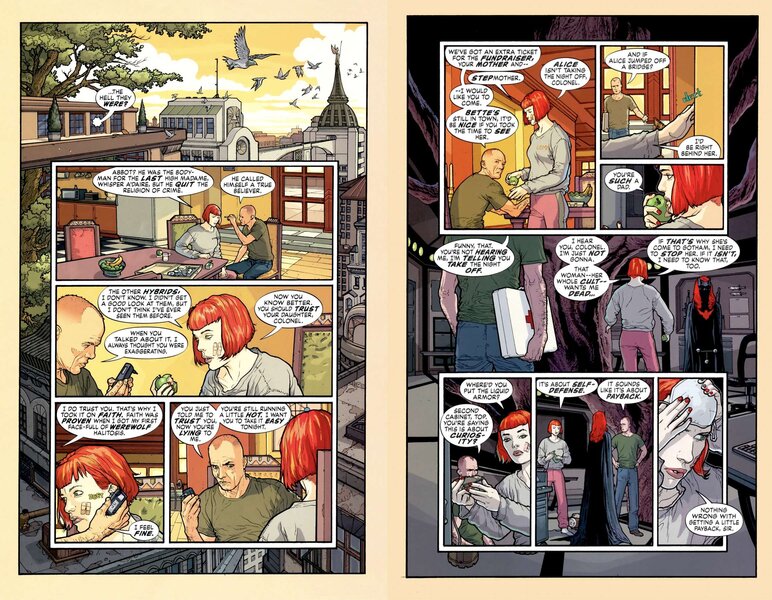Create a free profile to get unlimited access to exclusive videos, sweepstakes, and more!
Why you need to sit down with the glorious Batwoman: Elegy

Whether you're a fan of The CW's Batwoman or believe that Batwoman deserved better, look no further than Batwoman: Elegy (the collected edition of Detective Comics #854-860, 2009-2010), one of the primary narrative — and perhaps visual — inspirations for Season 1. If you've seen the series, you'll know of the fight between Ruby Rose's Kate Kane/Batwoman and Rachel Skarsten's Beth Kane/Alice, which is the story outlined in the comics. If you're in possession of the trade paperback, it's actually up of two separate storylines that, together, make up Batwoman: Elegy (from here, I'll be using Elegy to refer to the entirety of the book itself, the trade edition of the collected issues #854-860).
The first four-part storyline (also named Elegy) consists of issues #854-857 — with sections named after musical terms: Agitato, Misterioso, Affettuoso, and Rubato — while the second is called Go, a three-issue storyline that illustrates Batwoman's origin story in installments of 20 years before, seven years before, and four years before. (Below is the two-page spread that introduces Part One: Agitato — try and tell me that's not the most badass character introduction ever.)
Arguably the story arc that cemented Batwoman's place in DC lore, it's obvious why The CW series chose Elegy as its springboard. It's also more than worth sitting down with the collected Elegy, frequently praised for the intense and stunning double-paged artwork put together by writer Greg Rucka, artist J.H. Williams III, and colorist Dave Stewart. The collaborators for Elegy came together to create a masterpiece of Batwoman (and DC) work, using her signature red color palette, unique bat-like panel breakdown, and emphasis on Batwoman's adaptive, ever-changing but still realistic form.
In other words, Elegy is a sight to behold. I handle my copy with the utmost care every time I hold its sleek, glossy pages in my hands, before returning it to its fingerprint- and retina scan-secured triple-paned protective glass case to be preserved for all eternity. But in all sincerity, comics are an immensely physical medium, and Elegy proves this, hands down. However, if you're unable to get your hands on a copy, we'll let some of the spreads from the book speak for themselves.
Elegy coexists in two worlds: Kate Kane's and Batwoman's, the former light with a hint of dark (see above) and the latter dark with a hint of light (see below). Unlike Batman, Batwoman stands out on the page and in the world not just as a red-haired superheroine, but as a queer woman; she does not shy away from being unique or individualized in either of her two lives. In her existence as Batwoman, she roams the streets at night and seeks vengeance for those who tried to kill her, a sharp contrast from her equally smart-talking yet overshadowed alter-ego, Kate.
The superhero's shining presence during dark hours is a defining feature of Batwoman's nighttime world, and she takes on an entirely new quality as Batwoman, from her starkly pale face to her change in presence as she takes up space on the page, dominating evil and protecting Gotham City. The collaborators on Elegy also take care to differentiate it from Batman's dark, gloomy world so recognizable and well-known in the comics and now in film and other visual forms. It is not just a world of the night, it is Batwoman's world of the night, and she is its protector.
Perhaps the most distinctive feature to stand out to a reader of Elegy is the red and black color palette that permeates the eponymous superhero's nighttime world, marking it as hers to safeguard and not Batman's. The sharp red color is Batwoman's emblem; her boots, gloves, belt, wig, lips, inside of her cape, and bat symbol adorning her chest, not to mention her natural hair, are all this shocking red. It is impossible to ignore the red shining through at every point on the page and in the spread, identifying both the page and the world itself as Batwoman's to protect and hers alone.
In an addendum at the back of Elegy, Rucka writes in the original script for another spread (this article's cover image at the top of the page) in for the collected edition: "In a Batman book... we'd see Batman come out of the shadows behind [the doctor] or something like that. I don't want to do that here with Kate; it's against her character... Batwoman has been waiting... but she's not trying to scare her or ninja-tactics her." As Rucka suggests, Batwoman doesn't hide, and she doesn't skulk in the shadows like Batman. The reader even gets a glimpse of Batman in the last few panels of an early spread (above), his figure and all-black outfit a mere outline behind the silhouette of a building, while Batwoman's hair is prominently depicted, an emblem of Batwoman's defined, proud existence in her world.
Batwoman's continued presence on the page and in the world goes beyond her color scheme and extends in the distinctly drawn panels, building Batwoman's world around her identity as its protector. Although each page in the spread might stand on its own, the identical layout of the pages makes it easy to associate with each other, and they connect into one cohesive sub-plot. The distinct panel shapes function not only as a stylistic element but also as a narrative element to build Batwoman's character as an integral part of her world through a story. Many of the spreads in Elegy are permeated by panels constructed and contained by the bat shape (below and in many of the other spreads) — she is literally the keeper of the story and the world.
And let's face it: Batwoman herself is undeniably sleek and undeniably cool. (Women want to be like her... women also want to be with her.) This is plenty owing to the artistry of J.H. Williams III, who uses a near-realistic style of drawing to craft her world, emphasizing detail in Batwoman's body in contrast with the otherwise blurry and indistinct environment of the world of the night to cement her presence as the defining feature of the world. Williams' depictions of Batwoman and other characters in Batwoman's world of the night are faux-realistic in nature, the characters drawn in great detail, from the strands of Batwoman's hair and to every streak of reflection on her cape. On the other hand, Batwoman's environment is almost entirely composed of shapes and areas of color, abstract forms overtaken and dominated by her presence in each panel. Although the world around her may be mere shadows, this serves as a way to identify her world: a cold, dark mass without Batwoman's shining light to guide it.
Batwoman's world of the night even extends upon that of the content on the page itself, using its material nature to affirm Batwoman's status as protector of this world that exists in full color and flesh, filling each page and spread. The red of Batwoman's features leaps off the page when a light is shone on the page, and each page is filled with art like a painting, Batwoman's world utterly and completely filled. Flipping through the book, there is a barely a blank space, and even when there is, it is black. Holding the spread in one's hands, Batwoman's world fills the page and is again dominated and characterized by Batwoman's distinct presence — pervasive and omnipresent.
She is simply just there in the world, each strategic move deliberate and calculated. Batwoman is everywhere at once; the reader gets her entire body, her boot, her glove, her face, her lips, her silhouette, her hair, and even just her cape. As readers, we are privy to Batwoman as a whole individual, not just a Batman-like shadow or specter floating through the night. This is Batwoman's world, and no accentuation is needed to assert her dominance and presence in the world; markings that would mark Elegy as a comic, save for word bubbles, are ultimately taken out of the mix entirely. Batwoman's environment is not a comic world; it is just a world, no descriptors necessary.
Like Kate Kane/Batwoman herself, Elegy is dependable and unapologetic. So what are you waiting for? Go bask in Batwoman: Elegy and our queer superhero's unique world of the night; discover the rest of the book's colorful secrets yourself. Say goodbye to Batman — here comes Batwoman at the helm. From the content to the page itself, Batwoman's presence is always there, serving Gotham City for now and always, preserved in a volume entirely devoted to her misadventures and adventure.
































